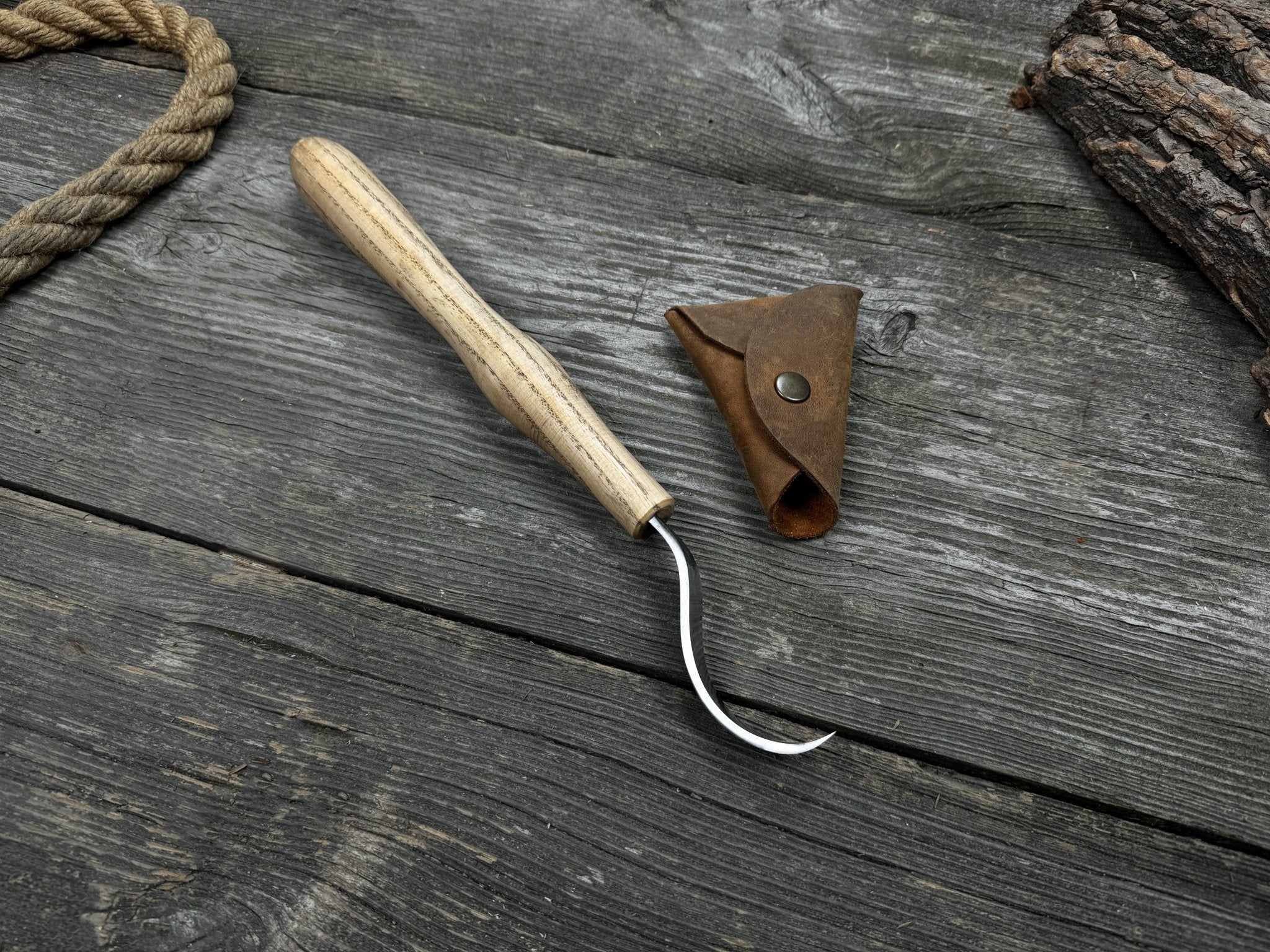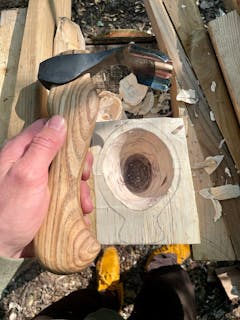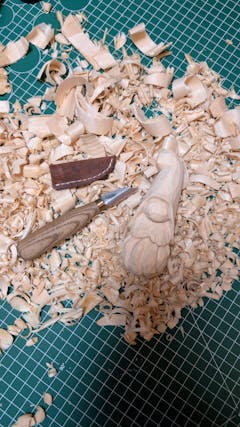What Are Hook Knives?
The hook knife, also known as a crooked knife, curved, or scoop knife, originates from Scandinavian wood carving traditions. It was traditionally used to create wooden utensils, while similar tools were used by Native American tribes to carve canoes, spoons, and other hollowed wooden items.
Today, a hook knife is defined as a specialized tool used for carving concave shapes, with a cutting edge perpendicular to the handle. The curvature of the blade varies, with tighter curves used for detailed projects and more open for larger cuts.
Unlike chisels and gouges, which are suited for flat, straight cuts and rounded, curved shapes, hook knives are made for hollowing and detailed work.
We will now explore the many types of hook knives, how each of them can serve you best, and some common carving techniques.
Types of Hook Knives
Hook knives for spoon carving can be categorized based on blade shape into three main groups: round, open, and compound.
- Round hook knives: With a fully round blade shape, these hook knives are ideal for deep hollowing cuts, such as those used in carving bowls or kuksa cups.
- Open hook knives: Featuring a gentle curve, these knives are better suited for broader sweeping cuts but are not suitable for deep hollowing.
- Compound hook knives: Their blades start as an open curve and then transition into a round curve, resembling a Fibonacci spiral.
Manufacturers may offer a range of shapes and sizes, depending on the product line, with variations in price, steel quality, and models.
To achieve the best results with these spoon carving tools, it’s important to match the knife’s shape and size to the hollow type you intend to carve, e.g.: for a small coffee spoon, a small round scoop knife works best, while for an eating spoon, a larger open or compound knife is ideal.
If we categorize hook knives based on their blade and handle design and functionality, they fall into these categories:
Single-Edge Hook Knives
- Blade functionality: These knives have a cutting edge on one side, typically inside the blade curve. This design ensures more control for detailed, single-direction cuts.
- Versatility: Suited for detailed concave work, limited to one direction of cutting.
- Portability: Usually fixed-blade knives, less portable, but more durable.
Double-Edge Hook Knives
- Blade functionality: These hook knives for spoon carving have two cutting edges on both sides of the blade, making it possible to do pull and push strokes.
- Versatility: More flexible for different techniques, suitable for advanced carvers.
- Portability: Fixed blades make them less portable, best for workshop setting.
Folding Hook Knives
- Blade functionality: These tools can be single- or double-edged. The blade folds into the handle for safe carrying.
- Versatility: May not be suitable for heavy-duty tasks due to their folding construction.
- Portability: Designed to be easy to use and carry. Perfect for traveling carvers.
Fixed Blade Hook Knives
- Blade functionality: The blade may be single or double-edged, permanently fixed. This design allows for more forceable motion and stability.
- Versatility: These hook knives offer stability while performing a wide range of carving tasks.
- Portability: They feature fixed blades and are bulkier to carry, requiring a sheath or case for safe transport.
The common characteristics of blade steel, handle shapes and materials, and ergonomic features are as follows:
Blade Steel Characteristics
- High-carbon steel: Knife with hook blade made of high-carbon steel or plain carbon steel offers excellent edge retention and sharpness. However, it requires regular maintenance to prevent rust.
- Stainless steel: May not hold a cutting edge as long as a high-carbon hook knife can. However, stainless steel knives are corrosion-resistant and can be used in humid environments.
- Laminated steel: A hook shaped knife using laminated steel has the best of two worlds. It uses hard core and softer outer layers, making it durable and sharp.
- Textured or coated steel: Coated and textured steel enhance the visual appeal of the wood carving hook knife. Additionally, the texture on the blade can provide extra grip, which is especially useful when working with hardwoods. Coated blades, like Teflon or other materials, reduce friction between the blade and the wood. Coatings may help protect the hook knife for spoon carving from corrosion and rust. Some coatings increase the wear resistance of the blade, making it more durable.The blades often have a steel curved profile optimized for hollowing tasks, with a precise blade projection to allow for smooth and controlled cuts.
Handle Shape and Materials
- Straight handles: Typically made of hardwoods, straight handles provide a classic aesthetic. They add versatility to the scoop knife and offer a solid grip.
- Oval handles: Oval handle is favored by many carvers for its comfort. It fits comfortably in the hand and reduces fatigue during long carving sessions.
- Contoured handles: These models of handles provide even more comfort, as they are custom-shaped, which increases their ergonomics.
- Rubberized handles: Some hook shaped knives feature rubberized steel in the handle for better control and grip.
Ergonomic Features
- Grip: Try out ergonomic handles and those made from rubber and similar materials. This can enhance comfort and control and also reduce strain.
- Balance: Proper weight distribution across the blade and the handle improves effectiveness of the spoon carving knife and increases accuracy.
- Custom fit: Some manufacturers offer handles of different sizes. This custom-fit approach ensures a knife with hook blade feels natural in your hand.
- Anti-slip features: Contoured designs of the handles, as well as textured and rubberized grips, prevent accidental slipping, making the tool safer.
Uses and Applications
The applications of the hook shaped knife go beyond wood carving. Being very versatile in shape and size, this tool is an irreplaceable assistant in crafting intricate leather designs and pruning plants in your garden. Let’s find out how these tools can effectively be used in wood carving, leather crafting and gardening.
Wood Carving
In wood carving, a knife with a hook blade does all the scooping and hollowing work. When the blade shape matches the actual design, this carving knife allows to avoid grooves, making surfaces look really smooth.
A knife with hook on end allows it to reach tight spaces, like corners, making this tool suitable for detailed carvings. Thanks to the versatility of the blade curvature, these knives can also be used for broad, sweeping cuts. Their blade shape allows for the removal of large amounts of wood, which is very useful at the beginning of a project.
Leather Crafting
Knives with hooks are also used widely in leather crafting, particularly in creating fine patterns and cutting out specific shapes from larger leather pieces. Their blades can reach areas that straight blades cannot.
The curvature of the blade makes these carving knives suitable for trimming excess leather with a clean, professional finish. These tools are also used to thin the edges of the leather to make them easier to stitch or glue together.
Gardening and Pruning
In gardening, hook knives are perfect for pruning small branches and stems without damaging them, as their blades allow for making precise cuts at a specific angle.
They can be used for harvesting fruits and vegetables, especially the ones that grow in clusters or those that have tough stems. Removing weeds is another common application. The knife blade can clean the roots from the weeds growing very close to the soil surface with minimal disturbance to the surrounding soil.
In decorative gardening, hook shaped knives can help shape shrubs and plants, creating specific forms.
How to Properly Use a Hook Knife
To achieve high accuracy when using a knife with a hook, you need to practice proper techniques, follow safety precautions, and avoid the mistakes many carvers may make, especially in the beginning.
Basic Techniques
- Hand position: Hold the hook knife firmly, with the edge of the blade facing you. Use your thumb to control cuts, their depth and direction. Hold the workpiece stably with your other hand.
- Carving movements: Work from the center of the wood piece and pull the blade towards you. To achieve better control over your motions, use your fingers to guide the knife along the wood grain.
- Hollowing cuts: Start with shallow cutting to form the shape you want to achieve, and then slowly deepen the cuts, removing thin amounts of wood to prevent overcutting.
- Finishing cuts: Refine the details of the carving with smooth, controlled strokes.
Safety Tips
- Timely maintenance: Make it a rule to check your carving tool before starting a new carving project. Ensure the blade is sharp and tightly secured, as a loose blade might slip off the handle, resulting in injury.
- Safe hand position: Keep your fingers away from the cutting path. Use thumb guards and gloves for more safety.
- Work environment: Ensure your workspace is well-lit and free of any distractions. Consider using clamps to secure the workpiece to the workbench.
Common Mistakes to Avoid
- Cutting too deep: If you start your project by making deep cuts, it may ruin the entire workpiece. Be more patient and begin with light, shallow cuts first.
- Disregarding grain direction: If you are carving a wood spoon, the grain should run from top to bottom, not from left to right, as this will weaken the spoon handle. So, it’s a golden rule to always cut along the grain.
- Ignoring regular tool check-ins: Failure to timely sharpen the tool or fix the loose handle can lead to accidents and poorly executed projects. Check your tools regularly to ensure they are sharp and securely fastened.
Conclusion
Hook knives are versatile tools essential for wood carving, offering smooth finishes and high precision. Beyond wood carving, their applications extend to grafting, harvesting, pruning, and leather crafting. The key features of a good hook knife include ergonomic handles, and durable, easy-to-maintain materials, all of which contribute to its efficiency and make it irreplaceable in various crafting tasks.
Some of our final recommendations for you would be:
- Start with a basic set of tools and invest in more specialized tools to expand your capabilities.
- Remember to always match the knife to the task. Choose the appropriate blade shape and size for the task at hand. This ensures optimal results and prevents unnecessary cutting actions.






